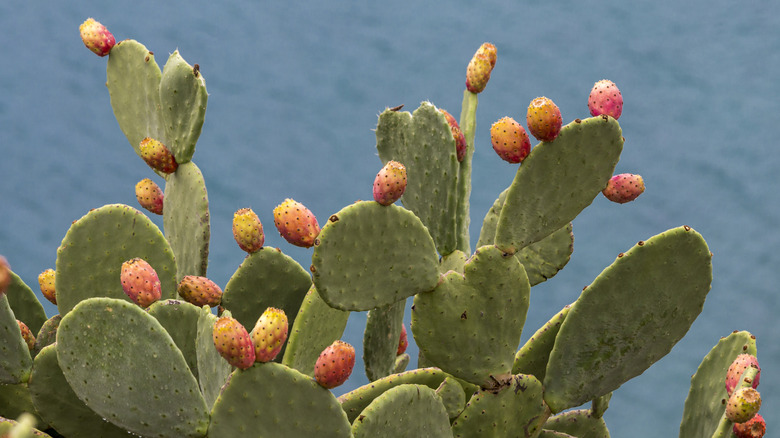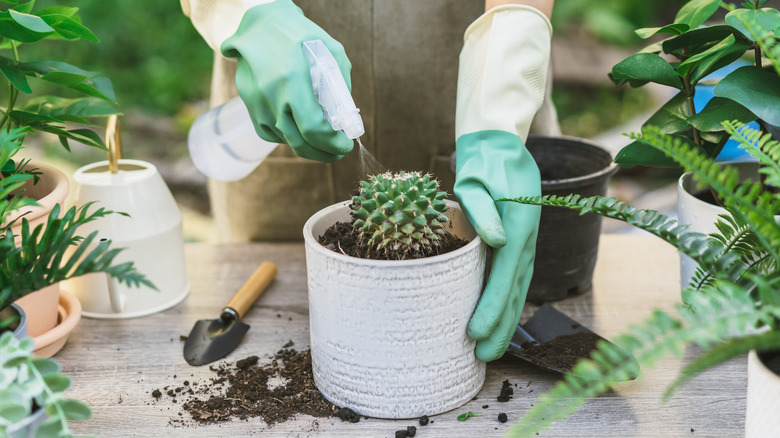Give Your Outdoor Space A Western Touch With A Prickly Plant Privacy Fence
Privacy is something most of us want when we're frolicking in our backyards, but that's sometimes easier said than done. If you want to combine the look of a house decorated like it's straight out of "Yellowstone" and gain some extra seclusion, we have tips for bringing your backyard to life without compromising aesthetics — by creating a living fence with cactuses and other prickly plants.
As a symbol of the Old West, cactuses help create a serene, western-inspired retreat while doubling as a prickly backyard deterrent for nosy neighbors. Thanks to their thorny exteriors, well-placed cactuses can make unwanted intruders think twice before hopping over your fence or invading your garden. From the jumping cholla cactus (Cylindropuntia fulgida) that offers the perfect western-y outdoor accent barrier to the ladyfinger cactus (Echinocereus pentalophus) that's covered in star-shaped spines, you have a slew of different types, sizes, and shapes to pick from.
Whether you live in a region with a built-in Western feel or you're coming up with ways to create your own, a living privacy fence with cactus plants and succulents gives you a natural barrier and a distinct Western aesthetic. Just make sure to pop in your zip code using the USDA Plant Hardiness Zone Map to determine which plants will thrive best in your location, as cactuses prefer dry, arid climates. Although there are plenty of Western decor trends you might live to regret having in your home, we're positive you won't regret lining your property with some of the most majestic desert plants.
How to create a living cactus fence
As much as we love the idea of planting a saguaro cactus (Carnegiea gigantea), which looks like it is in a perpetual state of cheer and is one of the tallest cactuses in the U.S., it can take up to 100 years to reach its peak height. When you don't have that kind of time, other types of cactuses and succulents can create a western-inspired prickly plant privacy fence. And once you've done your research, now you can pick out your plants.
The prickly pear cactus (Opuntia humifusa), the official plant of Texas, can usually tolerate zones 7 through 11. It's not the tallest succulent, but it can grow up to 8 feet wide and 5 feet tall within about three to five years. You can use it to cover quite a large area for extra privacy or just grow a prickly pear cactus for gorgeous colorful flowers. Those living in zones 4 to 11 should try the Adam's needle (Yucca filamentosa) succulent plant. This drought-tolerant plant has blade-like leaves with sharp spine-y ends, and can grow a dramatic flower cluster on a tall stalk.
While not prickly per se, agave (Agave americana) plants do have swordlike leaves with dramatic, spiky edges that will add an instant, rugged mood to any landscape. They require very little maintenance for those living in zones 7 to 11, and can live up to 30 years. However, be aware that some cultivars may not do well in zones 7 or 8.
Caring for your outdoor desert landscape
The great thing about cactuses and succulents is that they require very little maintenance. Just give them mostly dry weather conditions, some sunshine, an occasional drink of water, and they're ready to make your backyard their permanent home. Although every cactus type is different, most have the same general instructions. Cactuses that are planted under too much sun can get what experts call a sunburn, which causes a yellowed-looking appearance that will eventually kill that part of its skin, so therefore, planting it under filtered sun is best. You don't have to worry about pruning a cactus because it'll grow into its own unique and interesting shape over time.
Some people wrongly assume cactuses can survive without water, but they can't. When a cactus develops a wrinkled appearance, it means it's actively growing — mostly during the spring and summer. And that's when you want to water it. Just be sure to let the soil completely dry out before watering it again. You might go weeks or even months in between waterings. Cactuses are the type of plant you can virtually bring back from the brink of death by adding water to the top layer of soil — just in case you forget to water it. If you're planting a cactus in a pot, make sure to choose one that has drainage holes so its roots don't rot.


